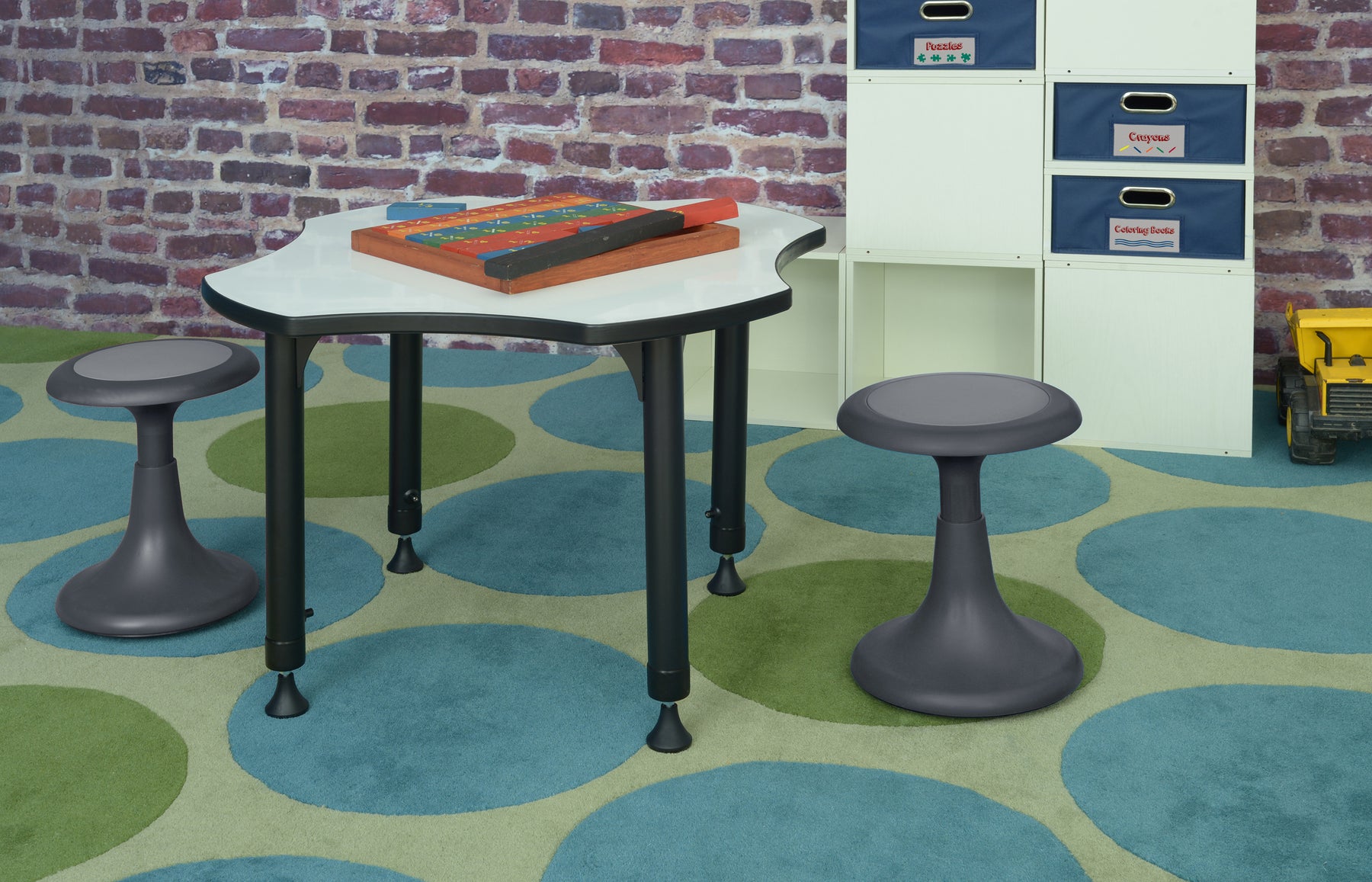
How Flexible Seating Can Help Students on the Autism Spectrum
What Are Wobble Stools?

Wobble stools, also known as wiggle seats or wiggle stools, are small stools designed for kids. They have rounded bottoms that allow them to wiggle and wobble on the floor. Sounds a bit counterintuitive, right? Why would anyone actually want to sit in a seat that wobbles? Well, there are some great reasons why.
For one thing, they don’t wobble to the point that they’ll fall over. Any wobble stool worth its salt have balance factored into its design. As long as someone is sitting on it with their feet on the ground, the sitter won’t have to worry about tipping over. Plus, wobble stools with non-slip padding prevent any unwanted slipping.
There are some variations on wobble stools to consider. Some have fabric cushioned seating. Other might have more simple padding. Some wobble stools are even designed to be height adjustable, meaning even older students with autism can use it. When it comes to young students with autism, there are several benefits to consider.
What Are the Benefits?
With students on autism spectrum, dynamic seating is often key to their ability to learn. According to a study by the Iranian Journal of Child Neurology, “Children with autism are supposed to select self-stimulatory behaviors, such as stereotyped movements to normalize arousal levels.” They went on explain that students who could move around while sitting could normalize their sensory load. These students “could be satisfied physiologically and would not need to engage in self-stimulatory behaviors.” The study went on to state, “Since agitation and attention deficiency seem to be due to sensory integration impairment, sitting modification in class condition may be beneficiary to students with autism.”
With wobble stools, students with autism have a seat that engages and stimulates them. Their feet and legs would have to can engage, so they won't need other ways to stimulate themselves. According to a study from Southern New Hampshire University, “Using options like wiggle stools and scoop chairs makes it so that students are active. Physical activity increases oxygen flow to the brain, blood flow, and core strength.” And while exercise balls are also helpful, they can be distracting. Wobble stools provide the same benefits while blending into the classroom aesthetic.
Well-designed wobble stools also encourage good posture. So, not only can it be helpful for a child’s learning development. It can also provide a healthy physical development. And using height-adjustable wobble stools can only create more space for different types of students. Even older students with autism can enjoy them.
Where Do Wobble Stools Work Best?
Wobble Stools can work in any environment designed to be part of a child’s education. Classrooms are the obvious locale for these stools. Another place is a library, where children need focus on reading or studying. They could also work well inside of a playroom for Pre-K students. Finding colorful options will make the seating look like fun and engaging.
Of course, many students are now going through temporary at-home learning. They could even be transitioning to permanent homeschooling. In those cases, a wobble stool might be even more beneficial. The Southern New Hampshire University conducted a study on the effects of flexible seating with at-home learning. 87% of teachers surveyed for the study reported positive behavior changes. These changes were reported whenever students could use flexible seating options. And 0% of the surveyed teachers reported any negative changes.
Don’t Take It From Us
We were able to talk to a couple educators ourselves. We interviewed both Tracy Greenamyer and Ginette Jaramillo. Mrs. Greenamyer is a 4th grade teacher at Hubbard Elementary in Hubbard, Ohio. Ms. Jaramillo works for the Stark County Educational Service Center at Louisville High School. She works as part of their Emotional Disturbance Unit (ED Unit), working with grades 9-11. Both Mrs. Greenamyer and Ms. Jaramillo work directly with neurodivergent students. Here’s what they had to say about the benefits of flexible furniture:
TOP- “Do you notice any consistent physical struggles for neuro-divergent students in the classroom?”
Greenamyer- “I notice they have an increased amount of movement and need to release energy through small motor to large motor movements. They tap, rock, shuffle their feet, etc. They like large areas in the room to walk around or make a lap or two.”
Jaramillo- “My students mainly have social-emotional regulation, ADHD, and Autism. Physically, they may need to move around more than atypical learners.”
TOP- “How much of an impact do you think the right furniture can have for these students?”
Greenamyer- “Furniture makes a large impact on the students because as the day progresses, their medicines may wear off or their frustrations with the schoolwork may increase. Often, these students will increase their physical activity throughout the day. As basic as it may seem, some furniture makes sounds when the kids rock or the desks are too small and are restrictive to those students.”
Jaramillo- “Furniture that allows students to stand and work comfortably or sit and have movement such as from an exercise ball or wiggle seat have a visible impact on the students and could even help them focus more, leading to a positive academic impact.”
TOP- “What kinds of furniture have you seen make the best kind of impact?”
Greenamyer- “The best school furniture pieces are ones that are flexible. I wish I could raise the student desks by myself without the aid of the custodian.”
Jaramillo- “Flex-seating… standing desks, bean bag chairs, wiggle seats, exercise ball chairs, or even desk/chair bands have seemed to make the best impact on students who especially have trouble focusing due to their ADHD.”
TOP- “How much of an impact have wobble stools had on your students?”
Jaramillo- “I have had students in other settings use these types of chairs to help channel their physical energy in a non-distracting way. Being able to get out their energy helps these students focus on the teacher as opposed to them running or walking around the room. (Typically, it is younger students such as elementary using these chairs) It would be interesting to see how my high school students would benefit from these seats.”
Out of the two, Ms. Jaramillo had stronger praise for the wobble stool in particular. Yet, both educators emphasized the importance of flexible seating. It puts it in real perspective to hear it from two women working hands on with students on the spectrum.
Where Do We Go from Here?
Remember, it’s okay to be different. Our differences are something to celebrate, not bemoan. Sometimes even our needs are different, and that’s also okay. If your child or student has been struggling in their education, a wobble stool might help them get back on track.
Don’t just take it from us. Take it from the experts! There is no downside to bringing a wobble stool into a child’s educational environment. Our hope is that as more educators adopt flexible classroom seating, more and more students with autism will flourish.
A Brief Disclaimer
On behalf of Regency, Inc. and The Office Place, we’d like to offer a disclaimer. Our field of expertise is furniture. We do not claim to be experts on people who have what's often referred to as ASD (Autism Spectrum Disorder). But we will be utilizing certain language about this community based on our research.
We based our research on professional experts and members of the community of people with autism. Thus, we will be using person-first language for this article; IE, “students with autism” or “students on the autism spectrum”. We will also cite this research to make our claims about the design benefits of a wobble stool.
We recognize there is wealth of diverse thought and information on this subject. Whatever claims we make is in no way meant to invalidate the views or lives of people with autism or their allies.
Sources
https://www.ncbi.nlm.nih.gov/pmc/articles/PMC5329757/
https://academicarchive.snhu.edu/handle/10474/3637
https://search.informit.org/doi/abs/10.3316/informit.761324590799585
https://autisticadvocacy.org/about-asan/identity-first-language/
https://ojs.unisa.edu.au/index.php/tahs/article/view/1561
Tracy Greenamyer, Hubbard Elementary
Ginette Jaramillo, Stark County Educational Service Center
